Mastering river crossings while hiking is essential for safety and enjoyment in the wilderness. Start by evaluating risks, such as water depth and speed. Use trekking poles to test stability, and gear up with waterproof bags to protect your belongings. Always face upstream during crossings to maintain balance, employing diagonal paths to reduce resistance. Choose wide, shallow sections with visible exit points, avoiding high or swiftly rising waters. Group coordination, like using a tripod formation, further guarantees safety. By understanding the dynamics of river conditions and practicing proven techniques, you can confidently tackle river crossings and enhance your hiking adventures.
Key Takeaways
- Evaluate river conditions by assessing depth, speed, and potential hazards like submerged rocks.
- Choose crossing points at wide sections with stable exit points to ensure safety.
- Use trekking poles and a diagonal path to maintain balance against the current.
- Coordinate group crossings with clear communication and a tripod formation for stability.
- Monitor weather forecasts to anticipate and adapt to changing river conditions.
Understanding River Crossing Risks
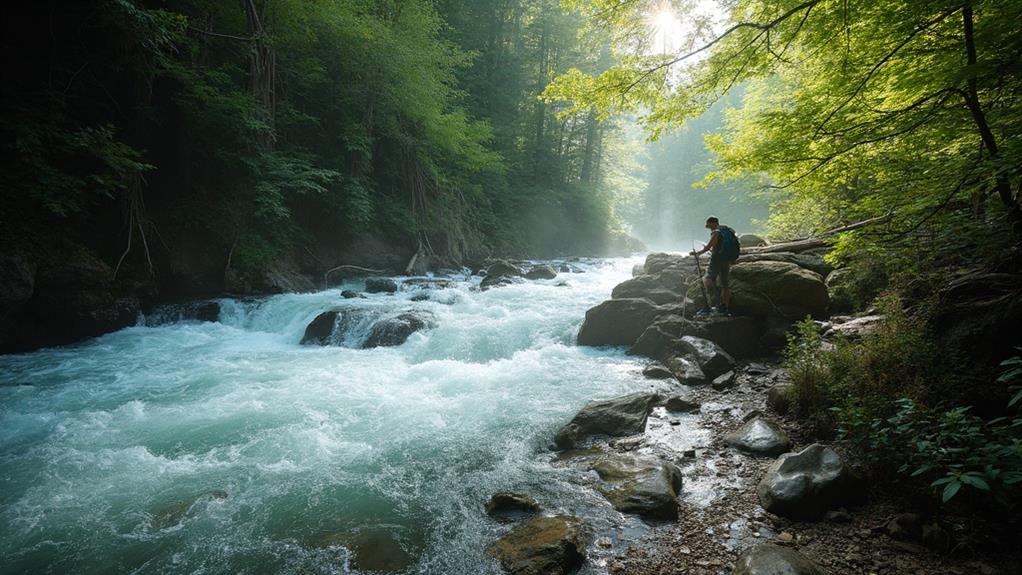
River crossings present one of the most notable hazards for hikers, with numerous incidents underscoring the necessity for thorough understanding and preparation. The perilous nature of these crossings is evident in their standing as a leading cause of fatalities among hikers, surpassing even wildlife encounters in U.S. national parks. This stark reality demands a heightened level of risk assessment and hazard awareness when approaching any waterway.
A detailed risk assessment is indispensable for safe river navigation. This involves evaluating the water conditions—depth, speed, and clarity—while maintaining a healthy respect for the power of rivers. Hidden dangers such as submerged rocks and strainers complicate the seemingly straightforward task of crossing, often misleading even seasoned hikers. Consequently, it is essential to approach every crossing with caution, considering that knee-deep or fast-flowing waters pose substantial threats.
Hazard awareness is equally important. Understanding the river's dynamics—how water flows and the potential for sudden changes—can greatly reduce the risk of slips and falls. A conservative approach, prioritizing safety over haste, is essential.
Recognizing Dangerous Conditions
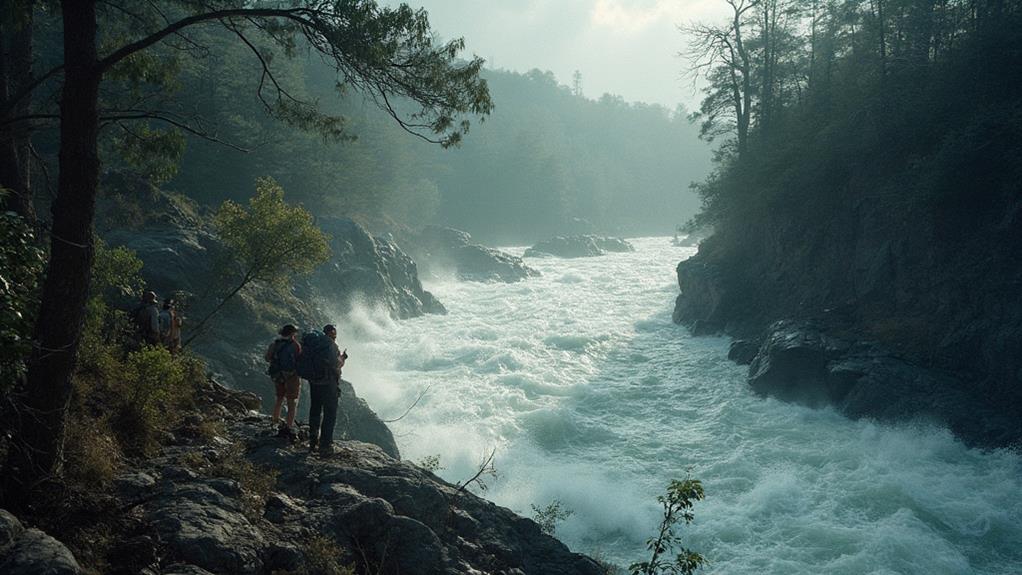
Building on the foundation of risk assessment, recognizing dangerous conditions is paramount for guaranteeing a safe river crossing. A thorough current assessment is essential as it allows hikers to gauge the river's power. Observing a stick's velocity as it floats downstream offers a practical method: if it moves rapidly, the river's current is likely too hazardous for crossing.
Coupled with this, hazard recognition involves avoiding rivers deeper than mid-thigh, as these depths considerably heighten the risk of being swept away by swift waters.
Additionally, the use of a trekking pole is invaluable in testing the riverbed's stability. This guarantees secure footing and assists in maneuvering the crossing with confidence. Always face upstream to better brace against the current, and employ a diagonal downstream path to maintain balance. This technique enhances control over the crossing process.
Weather awareness is vital; even minor rainfall can dramatically raise river levels, exacerbating conditions and transforming a previously manageable crossing into a perilous endeavor.
Choosing Safe Crossing Points
Identifying suitable crossing points is an essential skill for hikers seeking to navigate rivers safely and efficiently. Employing effective crossing strategies and conducting thorough terrain analysis are key components in ensuring a successful river crossing.
Begin by scouting both upstream and downstream to find the widest and easiest sections, as these areas typically feature lower water levels and reduced currents. Such features are favorable for a safer passage.
When examining potential crossing points, look for signs of frequent use, such as trampled vegetation or established paths. These indicators suggest safer routes utilized by other hikers, offering a reliable guide to traversing the waterway.
Additionally, avoid narrow bends or areas with visible hazards like boulders and waterfalls downstream, as they greatly increase the risk of crossing.
Key considerations for choosing safe crossing points include:
- Water Flow and Depth: Assess conditions carefully and avoid crossings during high or rising water levels.
- Exit Points: Select crossings near stable exit points on the opposite bank for a secure and easy exit.
- Hazard Evaluation: Steer clear of areas with visible dangers to minimize risk.
Essential Gear for River Crossings
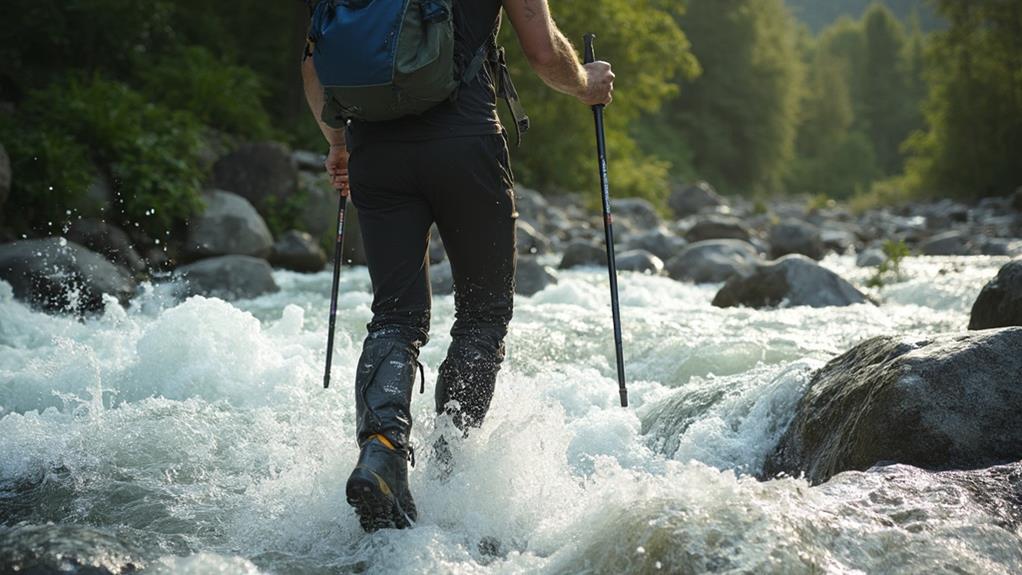
When preparing for river crossings, equipping yourself with the right gear is essential to guaranteeing both safety and efficiency. Selecting the appropriate river gear can make all the difference between a successful crossing and a potentially hazardous situation.
Among the crossing essentials is the use of waterproof bags or dry bags. These are critical for protecting important gear from water damage, keeping essentials dry and readily accessible.
Opt for lightweight, stiff-soled fording shoes instead of traditional hiking boots. These specialized shoes enhance mobility and reduce drag, a significant factor if swimming becomes necessary.
Complement your footwear with collapsible trekking poles, which provide invaluable stability and support in swift currents, helping to maintain your balance and prevent slips.
A stout staff or sturdy stick is another important piece of river gear. This tool allows you to gauge water depth and riverbed stability, offering an extra point of contact for balance and safety.
Techniques for Safe Wading
Equipped with the right gear, hikers can now focus on mastering the techniques for safe wading, an essential skill for traversing river crossings. The art of wading safely hinges on effective body positioning and deliberate foot placement.
To begin, always face upstream; this orientation allows you to brace against the current and quickly regain balance if needed. Crossing at a diagonal angle reduces water resistance, making it easier to maintain stability.
Foot placement is vital. Adopt a wide leg position and shuffle your feet slowly across the riverbed. This approach minimizes the risk of slipping on submerged rocks or uneven surfaces. Utilize trekking poles or a stout staff to probe ahead. This guarantees any hidden obstacles or sudden drops are detected before committing your weight.
To enhance stability, consider the following:
- Tripod Technique: Form a tripod shape by having a strong hiker lead while others provide mutual support.
- Support Tools: Use a sturdy walking stick for additional balance.
- Slow and Steady: Move deliberately, keeping a wide stance to maintain equilibrium.
Group Coordination and Safety
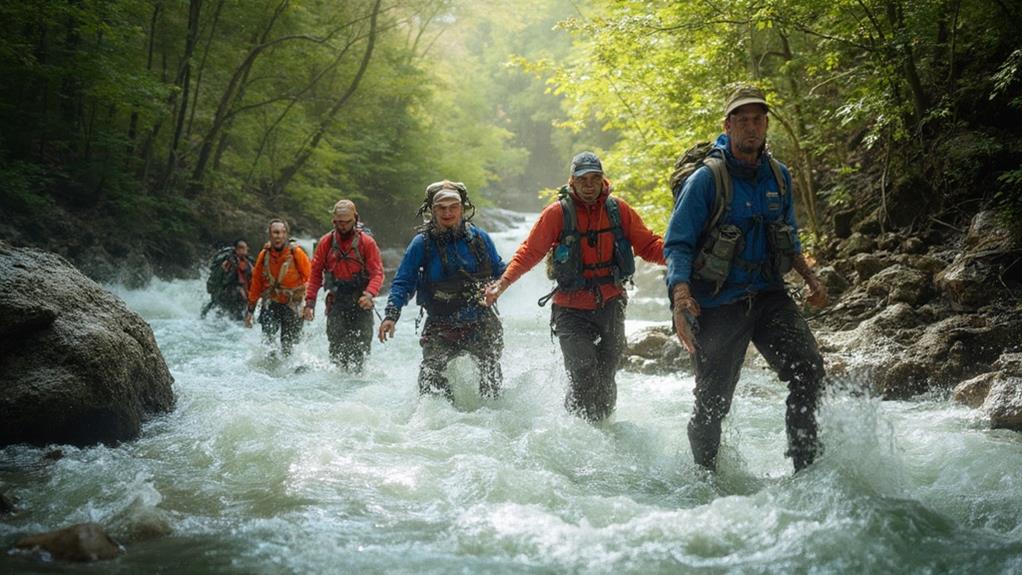
When approaching river crossings, effective group dynamics are essential to ensuring every member's safety and success.
Positioning the strongest hiker at the front to evaluate conditions while weaker members are centrally located can enhance stability and confidence.
Equipping your team with lightweight floating ropes and a clear communication plan for synchronized movement further fortifies the group's ability to navigate challenging waters with precision and care.
Effective Group Dynamics
Maneuvering river crossings during hiking expeditions requires not only individual skill but also effective group dynamics to guarantee safety and success. Establishing clear group roles and communication strategies is essential for coordinating movements and maintaining safety.
Positioning the strongest hiker at the front serves as a guide and stabilizer for less experienced members, assuring a secure formation. Communication is equally important; using strategies such as counting steps together or signaling movements helps reinforce group cohesion and synchronized actions, which are significant in traversing challenging currents.
Implementing proven techniques enhances group stability and reduces individual risks:
- Tripod Shape: Members hold onto each other's waists or shoulders, creating a stable structure against the current.
- Staggered Movements: Alternating movement within the group prevents all members from being swept away by strong currents.
- Two Points of Contact: Maintaining contact with the riverbed using trekking poles or hands and feet can increase stability.
Through these methods, groups can efficiently manage river crossings by leveraging collective strength and coordinated efforts.
Such disciplined coordination assures not only the safety of all members but also enriches the overall hiking experience, transforming potential obstacles into manageable tasks.
Safety Equipment Essentials
Adeptly managing river crossings on hiking expeditions frequently necessitates equipping each group member with essential safety gear to guarantee both individual and collective security. Lightweight floating ropes and trekking poles are significant tools, providing stability and support during crossings. These items are not merely accessories but fundamental components of one's safety arsenal, enhancing grip and balance against unpredictable river currents. Safety gear is complemented by strategic group coordination, making certain each member's role in the crossing is clear and practiced.
| Essential Gear | Role in Safety | Group Usage |
|---|---|---|
| Lightweight Ropes | Provides stability | Used by all for additional support |
| Trekking Poles | Enhances balance | Shared among group members for consistency |
| Spotters | Monitors progress | Positioned on banks to offer guidance |
| Emergency Protocols | Guarantees preparedness | Established and rehearsed before crossing |
Designating the strongest group member to lead, while others maintain contact either by holding onto each other or their packs, forms a stable tripod shape, enhancing group stability. Spotters stationed on both banks aid in monitoring and offer immediate assistance, making certain safety and adherence to emergency protocols. Clear communication and synchronized steps further fortify the group's crossing strategy, minimizing risks and fostering a confident, coordinated advance in challenging river terrains.
Coordinated Crossing Techniques
Equipping a hiking group with the right safety gear sets the foundation for successfully managing river crossings, but effective group coordination raises safety and efficiency to a new level.
A well-coordinated team uses techniques like the tripod formation to enhance stability. In this formation, the strongest hiker leads at the front, facing upstream, while weaker members are positioned securely in the center. This setup guarantees a robust defense against the river's current, providing a stable crossing experience for all members.
To further bolster group safety, establishing clear emergency procedures is essential. This includes preparing for potential rescues with equipment such as ropes or safety lines, which can provide critical support during challenging crossings.
Additionally, employing a synchronized count system helps groups maintain uniformity in movement, minimizing the impact of the current on individual footing.
Key group coordination techniques include:
- Tripod Formation: Position the strongest at the front, secure weaker members in the center.
- Emergency Procedures: Plan rescue strategies, use ropes or safety lines.
- Count System: Synchronized stepping to enhance stability.
Assessing Current and Depth
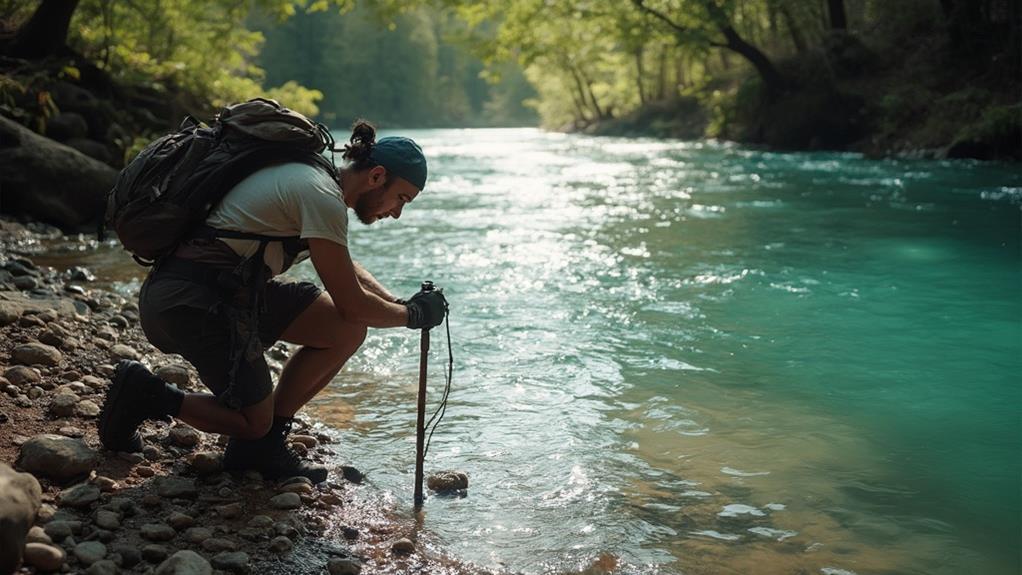
Successfully crossing a river while hiking requires a thorough assessment of both the current speed and water depth, as these factors can greatly impact safety. Engaging in effective current analysis and depth measurement is essential. The river current varies, being slower near the riverbed while faster at the surface, necessitating a complete evaluation before proceeding. Utilizing a trekking pole, hikers should measure the water depth, ensuring it remains below knee height to minimize the risk of being swept away. Observing floating debris such as sticks provides valuable insights into the current strength and direction, offering a clear understanding of the river's dynamics.
It is vital to remain vigilant about stream depth variations throughout the day. Factors such as rainfall or snowmelt can cause river levels to rise suddenly, complicating crossings. Submerged hazards, including rocks or strainers, should be carefully identified, particularly in murky waters where visibility is limited. Below is a helpful guide for river crossing assessments:
| Factor | Method | Safety Tip |
|---|---|---|
| Current Speed | Floating debris | Observe direction and speed |
| Water Depth | Trekking pole | Keep below knee height |
| Depth Variations | Monitor weather | Watch for rain or snowmelt changes |
| Submerged Hazards | Visual inspection | Scan for rocks and strainers |
| Surface Current | Observe visually | Note surface speed differences |
Ensuring a thorough assessment of these elements will enhance safety and confidence during river crossings.
Advanced Fording Methods
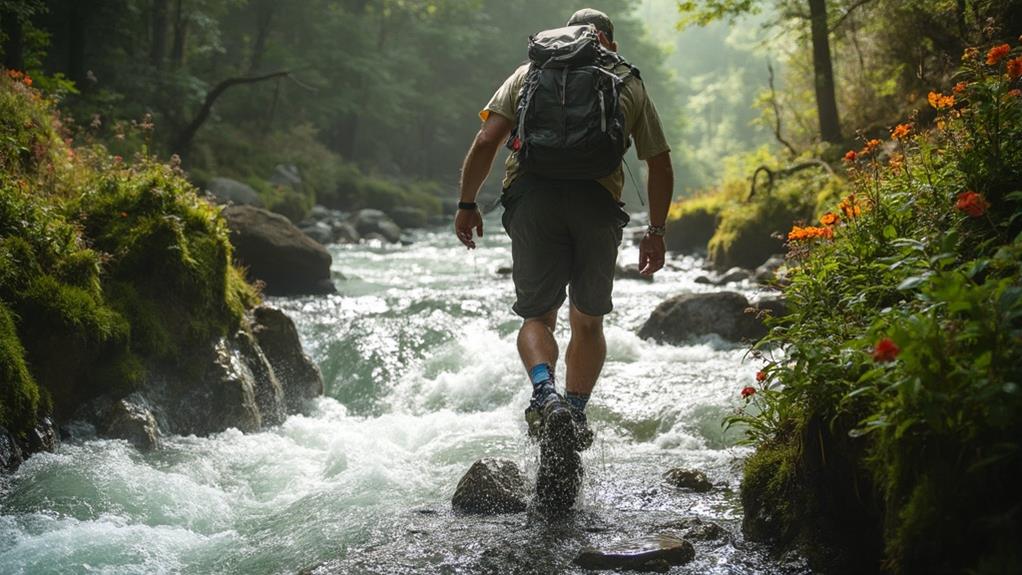
While a thorough assessment of river conditions is fundamental for safe crossings, mastering advanced fording methods enhances the level of safety and efficiency during backcountry expeditions.
Fording techniques that integrate skilled rope management are essential, particularly in deeper streams where stability is critical. A team of at least three experienced hikers is recommended to effectively employ belaying strategies, guaranteeing each member's safety as they navigate swift currents.
To optimize crossings, lightweight, floating polypropylene ropes paired with locking carabiners provide secure connections, reducing risks associated with turbulent waters. A double wrap of webbing around each hiker further bolsters stability, allowing for safer maneuvering across challenging terrain.
Brian Wilkins' research underscores the necessity of thorough training in roped fording techniques, illustrating their value in enhancing backcountry travel safety.
Key considerations when implementing advanced fording methods include:
- Approaching crossings at a slight angle: This reduces water resistance, aiding in balance and control.
- Maintaining a sturdy stance: Keeping knees slightly bent enhances stability.
- Utilizing effective rope management: Guarantees secure connections, minimizing potential hazards.
Responding to Changing Conditions
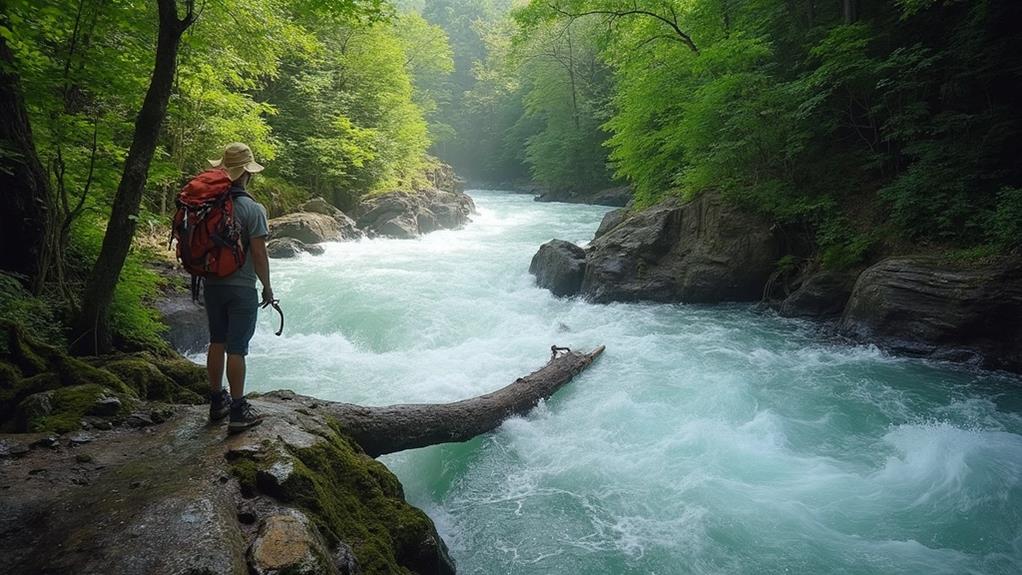
In the dynamic environment of river crossings, the ability to adapt to changing water levels and evaluate weather impacts is vital for safety.
Monitoring weather forecasts and observing river conditions, such as speed and depth, are essential practices to anticipate potential hazards.
Adapting to Water Levels
Adapting to fluctuating water levels is a critical skill for any hiker aiming to master river crossings safely and efficiently. Water level monitoring becomes essential, as rainfall or snowmelt can cause significant rises, particularly during certain times of the year.
Seasonal variations demand attention, with spring snowmelt or autumn rains posing distinct challenges. By consulting local weather forecasts and river conditions prior to the hike, hikers can better anticipate changes in water levels and enhance their safety measures.
To effectively adapt to these conditions, consider the following strategies:
- Timing Your Crossings: Opt to cross rivers early in the morning when water levels are typically at their lowest, minimizing risks associated with higher flows later in the day.
- Observational Techniques: Utilize natural features like rocks or vegetation to assess the river's depth and current strength, aiding in making informed crossing decisions.
- Flexibility and Safety: Always be prepared to alter your route or set up camp if water levels rise unexpectedly, prioritizing safety over speed.
Evaluating Weather Impacts
Keeping an eye on the weather is essential for hikers aiming to navigate river crossings safely. Accurate weather forecasting plays a central role in anticipating changes in river conditions. Sudden rain can drastically raise river levels and increase current strength, making crossings perilous. Hence, diligent river monitoring is important to guarantee safety.
Understanding snowmelt patterns is equally important, as warmer days can lead to increased river flows, particularly in the afternoons. Planning crossings in the early morning, when water levels are typically lower, can be a strategic decision.
Prolonged rainfall effects can saturate the ground, causing rapid runoff and altering river conditions even miles from the actual crossing. Swift temperature fluctuations can also prompt ice melt or sudden rainfall, requiring constant evaluation of river conditions.
| Weather Element | Impact on Rivers | Recommended Action |
|---|---|---|
| Sudden Rain | Increases levels and strength | Monitor forecasts closely |
| Snowmelt | Higher flows in afternoons | Plan crossings in early mornings |
| Prolonged Rain | Ground saturation, rapid runoff | Analyze recent weather patterns |
| Temperature Fluctuations | Alters conditions swiftly | Maintain constant vigilance |
Ultimately, reviewing local weather conditions is essential, as even minor storms can greatly change stream depth and speed, increasing risks for hikers.
Learning From Experienced Hikers
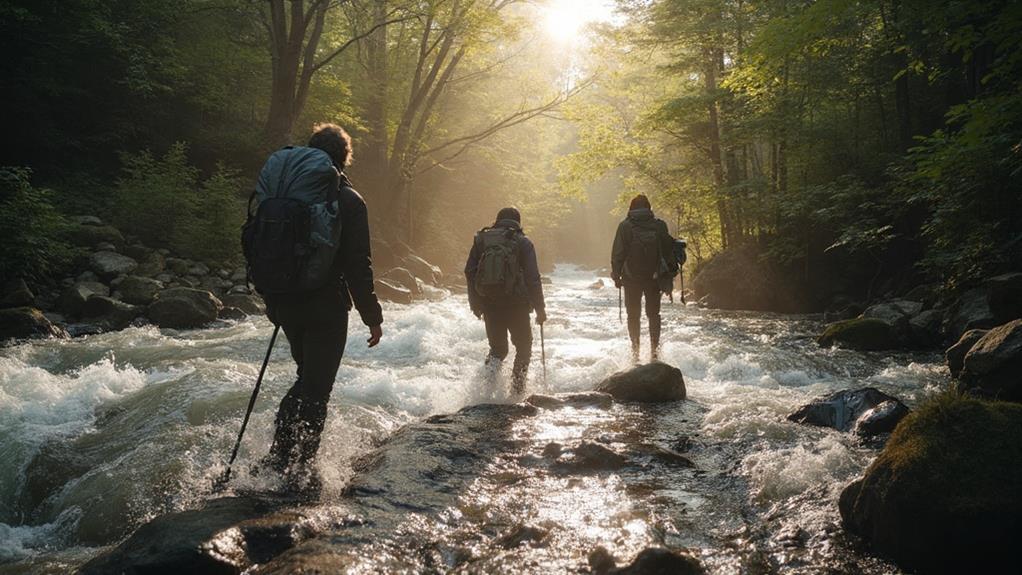
When starting on the journey of mastering river crossings, learning from experienced hikers can be invaluable. Hiker anecdotes and skill sharing provide a wealth of knowledge that can enhance safety and proficiency.
For example, seasoned hikers often recount their experiences, emphasizing the importance of thorough pre-crossing assessments, such as monitoring water levels and current strength. These tales serve as practical lessons, offering insights into the preparation required for safe river crossings.
Skill sharing among veteran adventurers is another critical aspect. Many recommend practicing crossing techniques with trekking poles and experimenting with various fording strategies. This hands-on approach builds confidence and preparedness for diverse conditions encountered in the wild.
Engagement with the hiking community is essential for continual learning. Forums and community discussions offer a platform for exchanging valuable experiences and tips. Additionally, local hiking groups and workshops provide opportunities for firsthand learning from those who have successfully navigated challenging river crossings.
Key insights include:
- Pre-crossing assessments: Importance of evaluating water levels and potential hazards.
- Crossing techniques: Practicing with trekking poles and exploring strategies.
- Group cohesion: Maintaining communication and support during crossings.
Frequently Asked Questions
How to Cross Rivers When Hiking?
When crossing rivers while hiking, prioritize safety by evaluating conditions and employing effective crossing techniques. Utilize trekking poles for stability, cross at wide, shallow points, and maintain multiple ground contact points. Always prioritize patience and awareness over urgency.
What Is the Advice for River Crossing?
Effective river crossing requires adherence to safety precautions and mastering crossing techniques. Evaluate current speed and depth, use trekking poles for stability, face upstream, walk diagonally downstream, and collaborate in groups to enhance safety and minimize risks.
What Is the Best Way to Cross a River?
The best way to cross a river involves thorough current assessment and employing safety techniques. Select the widest, shallowest section, utilize trekking poles, maintain multiple contact points, and cross diagonally upstream. Prioritize safety by evaluating conditions beforehand.
What to Wear for River Crossings?
For effective river crossings, prioritize footwear options like waterproof shoes with strong grip and complement them with waterproof socks. Choose lightweight, quick-drying clothing materials to enhance mobility and comfort, while keeping a change of dry clothes accessible.
Conclusion
Mastering river crossings while hiking necessitates a thorough understanding of potential risks, recognition of hazardous conditions, and the selection of safe crossing points. Equipping oneself with essential gear and employing effective wading techniques are vital for safety. Analyzing the river's current and depth is imperative, alongside adopting advanced fording methods when necessary. Responding adeptly to changing conditions further guarantees safety. Learning from seasoned hikers enriches knowledge, enhancing both safety and confidence in executing successful river crossings.